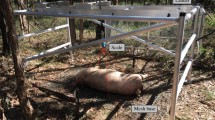Abstract
Several studies have been conducted on decomposition patterns and rates of surface remains; however, much less are known about this process for buried remains. Understanding the process of decomposition in buried remains is extremely important and aids in criminal investigations, especially when attempting to estimate the post mortem interval (PMI). The aim of this study was to compare the rates of decomposition between buried and surface remains. For this purpose, 25 pigs (Sus scrofa; 45–80 kg) were buried and excavated at different post mortem intervals (7, 14, 33, 92, and 183 days). The observed total body scores were then compared to those of surface remains decomposing at the same location. Stages of decomposition were scored according to separate categories for different anatomical regions based on standardised methods. Variation in the degree of decomposition was considerable especially with the buried 7-day interval pigs that displayed different degrees of discolouration in the lower abdomen and trunk. At 14 and 33 days, buried pigs displayed features commonly associated with the early stages of decomposition, but with less variation. A state of advanced decomposition was reached where little change was observed in the next ±90–183 days after interment. Although the patterns of decomposition for buried and surface remains were very similar, the rates differed considerably. Based on the observations made in this study, guidelines for the estimation of PMI are proposed. This pertains to buried remains found at a depth of approximately 0.75 m in the Central Highveld of South Africa.





Similar content being viewed by others
References
Crime Situation in South Africa (2014) South African Police Services. RSA: April to March 2004-2014: Provincial and National Figures and Ratios http://www.saps.gov.za/resource_centre/publications/statistics/crimestats/2014/crime_stats.php.
Beary MO, Lyman RL (2012) The use of taphonomy in forensic anthropology: past trends and future prospects. In: A companion to forensic anthropology, 1st Edition. Blackwell Publishing Ltd, Dirkmaat DC, pp 477–525
Pinheiro J (2006) Decomposition process of a cadaver. In: Schmitt A, Cunha E, Pinheiro J (eds) Forensic anthropology and medicine: complementary sciences from recovery to cause of death. Humana Press, Totowa, pp 85–116
Mann RW, Bass WM, Meadows L (1990) Time since death and decomposition of the human body: variables and observations in case and experimental field studies. J Forensic Sci 35(1):103–111
Gennard D (2012) Forensic entomology: an introduction. Wiley-Blackwell, Hoboken, pp 35–36
Bachmann J, Simmons T (2010) The influence of preburial insect access on the decomposition rate. J Forensic Sci 55(4):893–900
Amendt J, Krettek R, Zehner R (2004) Forensic entomology. Naturwissenschaften 91:51–65
Fiedler S, Graw M (2003) Decomposition of buried corpses, with special reference to the formation of adipocere. Naturwissenschaften 90:291–300
Galloway A, Birkby WH, Jones AM, Henry TE, Parks BO (1989) Decay rates of human remains in an arid environment. J Forensic Sci 34(3):607–616
Megyesi MS, Nawrocki SP, Haskell NH (2005) Using accumulated degree-days to estimate the post-mortem interval from decomposing human remains. J Forensic Sci 50(3):618–626
Comstock JL, Desaulniers JP, LeBlanc HN, Forbes SL (2014) New decomposition stages to describe scenarios involving the partial and complete exclusion of insects. J Can Soc Forensic Sci:1–18
Myburgh J, L’Abbé EN, Steyn M, Becker PJ (2013) Estimating the postmortem interval (PMI) using accumulated degree-days (ADD) in a temperate region of South Africa. Forensic Sci Int 229:165e1–165e6
Adlam RE, Simmons T (2007) The effect of repeated physical disturbance on soft tissue decomposition––are taphonic studies an accurate reflection of decomposition? J Forensic Sci 52(5):1007–1014
Keough N, Myburgh J, Steyn M. Scoring of decomposition: a revised method using a pig model. J Forensic Sci (in print)
Parsons HR (2009) The postmortem interval: a systematic study of pig decomposition in West Central Montana. MSc Thesis, University of Montana, Montana, pp 1–89
Taylor M (2011) A taphonomic study and post-mortem interval formula comparison. MSc dissertation, Cranfield University, pp 1–98
Sutherland A, Myburgh J, Steyn M, Becker PJ (2013) The effect of body size on the rate of decomposition in a temperate region of South Africa. Forensic Sci Int 231:257–262
Manhein MH (1997) Decomposition rates of deliberate burials: a case study of preservation. In: Haglund WD, Sorg MH (eds) Forensic taphonomy: the post mortem fate of human remains. CRC Press, Boca Raton, pp 469–481
Moffatt C, Simmons T, Lynch-Aird J (2016) An improved equation for TBS and ADD: establishing a reliable postmortem interval framework for casework and experimental studies. J Forensic Sci 61(S1):S201–S207
Myburgh J (2010) Estimating the post-mortem interval using accumulated degree-days in a South African setting. MSc dissertation, University of Pretoria, South Africa, pp 1–151
Tracqui A (2000) Time since death. Encyclopaedia of Forensic Sciences London Academic Press, pp 1357–1363
Simmons T, Cross PA, Adlam RE, Moffat C (2010) The influence of insects on decomposition rate in buried and surface remains. J Forensic Sci 55(4):889–892
Rodriguez WC, Bass WM (1985) Decomposition of buried bodies and methods that may aid in their location. J Forensic Sci 30(3):836–852
Troutman L, Moffat C, Simmons T (2014) A preliminary examination of differential decomposition patterns in mass graves. J Forensic Sci 59(3):621–626
Schoenly KG, Haskell NH, Mills DK, BiemeNdi C, Larsen K, Lee Y (2006) Recreating death’s acre in the school yard: using pig carcasses as model corpses. Am Biol Teach 68(7):402–410
Niederegger S, Schermer J, Höfig J, Mall G (2015) Case report: time of death estimation of a buried body by modeling a decomposition matrix for a pig carcass. Legal med 17:34–38
Dent BB, Forbes SL, Stuart HH (2004) Review of human decomposition processes in soil. Environ Geol 45:576–585
Goff ML (2009) Early post-mortem changes and stages of decomposition in exposed cadavers. Exp Appl Acarol 49:21–36
Anderson GS, VanLaerhoven SL (1996) Initial studies on insect succession on carrion in southwestern British Columbia. J Forensic Sci 41(4):617–625
Author information
Authors and Affiliations
Corresponding author
Rights and permissions
About this article
Cite this article
Marais-Werner, A., Myburgh, J., Becker, P.J. et al. A comparison between decomposition rates of buried and surface remains in a temperate region of South Africa. Int J Legal Med 132, 301–309 (2018). https://doi.org/10.1007/s00414-017-1618-2
Received:
Accepted:
Published:
Issue Date:
DOI: https://doi.org/10.1007/s00414-017-1618-2




